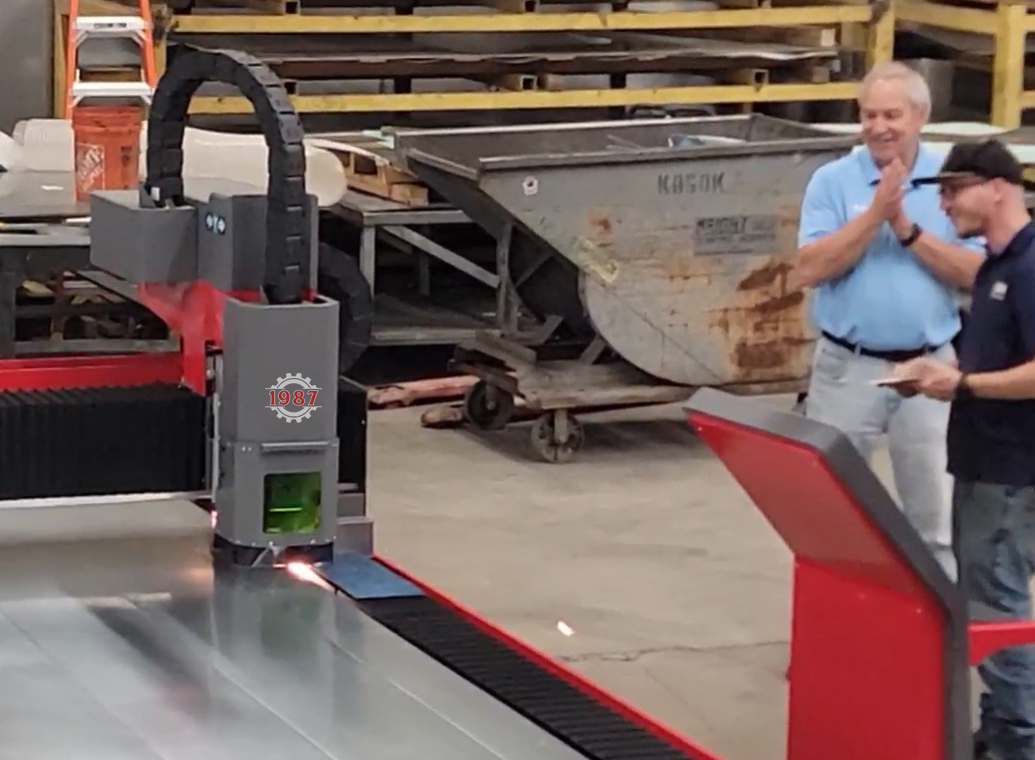
The process of selecting fabrication equipment isn’t just about specs, cost, or even brand recognition. For HVAC sheet metal shops like Kogok Corporation, the right machine is the one that saves time, eliminates bottlenecks, improves welding prep, and is backed by support that’s responsive when it matters most.
Founded in 1995, Kogok Corporation manufactures and installs commercial HVAC ductwork throughout the Mid-Atlantic. The company fabricates everything it installs — and often outsources fabrication when demand exceeds internal capacity. With five facilities and a constant flow of projects, fabrication speed, air quality, and cut precision directly affect operational continuity.
Their plasma cutting tables were becoming a liability. While functional, they introduced delays in welding, contributed to poor air quality, and created process inefficiencies that rippled across the shop. The switch to laser cutting, powered by a partnership with 1987 Machinery, resolved these challenges at both a technical and operational level, as previously slow cutting speeds were causing a bottleneck in production.
The challenge
Plasma tables, which rely on arc-based metal cutting, are notorious for leaving rough edges, especially when used on stainless steel. These jagged edges forced Kogok’s welders to spend extra time grinding and prepping each part before fabrication could begin. In a high-throughput operation, this grind time became a hidden but significant cost.
Beyond welding inefficiencies, plasma cutting generated large volumes of smoke and particulates. Even with proper ventilation, the surrounding environment would accumulate residue, affecting walls, floors, and air quality for everyone working nearby. Despite best efforts to mitigate the side effects, the shop’s atmosphere and cleanliness degraded over time.
The company needed a way to remove those inefficiencies while keeping up with the pace of HVAC ductwork production. A cleaner cut, faster turnaround, and better shop conditions weren’t luxuries. They were requirements.

Engagement
1987 Machinery had an existing relationship with Kogok’s operations team going back more than a decade. When Kogok began exploring alternatives to plasma cutting, Andrew Hess and Mike Hardesty from 1987 Machinery proposed a laser table solution — but not an off-the-shelf one.
The team at 1987 Machinery had re-engineered the typical laser table design. Instead of a bulky gantry system prone to vibration and mechanical drag, their approach mirrored the streamlined efficiency of a plasma table while retaining the precision of fiber laser technology. The result was a faster, more stable cutting platform with a patent-pending laser safety shroud.
The new system also included autofocus capability, eliminating the need for manual adjustments when switching between different gauges of sheet metal. This feature reduced human error and enabled consistently smoother cuts, regardless of material thickness. For shops that process multiple types of duct components each day, this automation simplified operator responsibilities and provided greater process control.
Installation and calibration were handled directly by Andrew and Mike. After placement, they completed final hookups for the chiller, compressor, and controls. Once powered, the laser table was dialed in using Kogok’s most common material gauges, and custom cutting parameters were developed on-site. Operator training followed immediately with hands-on guidance to ensure seamless adoption.
Results
Kogok now operates two laser tables from 1987 Machinery and has fully retired its plasma tables. The company’s partnership with 1987 Machinery has also led to many other benefits, such as:
Improved weld readiness
Parts cut on the new laser system require minimal post-processing. Welders receive clean, smooth edges that fit up quickly without time-intensive grinding. This has shortened fabrication cycles and allowed teams to focus on higher-value tasks.
Accelerated production
The laser tables operate at speeds that outpace human handling. Parts are ready so quickly that secondary staff are now assigned to apply labels and clear the cut beds in real time, just to keep up. This shift has redefined the cutting station from a single-user bottleneck into a two-person production node.
Cleaner shop environment
Airborne smoke and metal particulates — previously a constant presence near the plasma tables — have been dramatically reduced. Even without active ventilation, early test runs showed virtually no visible smoke from the laser cuts. This change has led to a noticeably cleaner work environment for staff and simplified maintenance of the surrounding facility.
Minimal downtime and trusted support
Support response times from 1987 Machinery have proven to be fast and effective. Rather than waiting days or weeks for callbacks or parts, issues are addressed immediately — often within minutes of an email, text, or phone call. This level of responsiveness eliminates unplanned downtime, maintains production continuity, and provides confidence in long-term equipment ROI.

Insights
Switching to laser cutting didn’t just speed up Kogok’s process — it reshaped how fabrication flows through the shop. With smoother cuts, reduced prep time, faster turnaround, and improved shop conditions, the impact extended far beyond the cutting station.
The laser tables are faster than the operators can manage alone, flipping the traditional production model. Instead of workers waiting on a machine, the machine now waits for material to be cleared and labeled. This reversal creates a measurable throughput advantage and sets the stage for higher production velocity without additional machinery.
Cleanliness also plays a bigger role than many metal shops account for. Reducing smoke and airborne contaminants improves not just compliance but the day-to-day experience for operators. When welders and fabricators spend less time grinding or dealing with poor visibility, they’re more productive, more efficient, and more engaged.
Most importantly, Kogok’s success with 1987 Machinery underscores a critical point about capital equipment investments: support is everything. A machine’s value isn’t just measured in inches per minute or watts per cut. It’s defined by the relationship with the supplier. When problems arise — and they always do — access to immediate, knowledgeable help determines whether production stays on track or grinds to a halt.
For Kogok, the right machine came from the right team. And that combination has reshaped the way ductwork gets fabricated.
To learn more about 1987 Machinery’s sheet metal solutions, including service, support, and fabrication systems tailored to your operations, visit 1987machinery.com.

